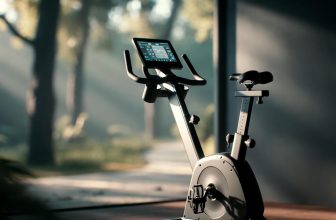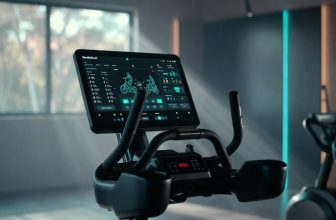Table of Contents
- Does Peloton Require Cycling Shoes?
- Peloton Pedal System and Shoe Compatibility
- Safety Considerations for Regular Shoes on Peloton
- Accessories to Ride Peloton Without Cycling Shoes
- Toe Cages
- Flat or Dual-Sided Pedals
- Advantages of Using Peloton Cycling Shoes
- User Insights and Statistics
- FAQ
- Can I use Peloton without any shoes?
- Are toe cages included with Peloton bikes?
- Can I use SPD cleats instead of Delta on Peloton?
- How long do Peloton cycling shoes last?
- Are cycling shoes worth it for casual Peloton users?
- Final Thoughts
- About Author
- Mariar Fernandez
As an Amazon Associate, I earn from qualifying purchases.
Does Peloton Require Cycling Shoes?
Does Peloton Require Cycling Shoes? No, Peloton does not require cycling shoes; you can use regular shoes with toe cages or flat pedals for safe, low-intensity rides. However, clip-in cycling shoes with Look Delta cleats maximize efficiency and safety.
Peloton Pedal System and Shoe Compatibility
Peloton bikes feature Look Delta clipless pedals, designed for cycling shoes with three-bolt cleats. These secure your feet, optimizing power transfer and reducing strain during intense rides. Regular shoes, like sneakers, lack cleats, relying on friction, which is less stable for high-resistance or out-of-saddle classes.
Peloton’s official site states clip-in shoes enhance pedaling efficiency by engaging quads and hamstrings on both upstroke and downstroke. Without clips, you lose up to 15% efficiency, per a Journal of Sports Sciences study, impacting calorie burn and performance in rides over 20 minutes.
Safety Considerations for Regular Shoes on Peloton
Using regular shoes increases slippage risk, especially during sprints or climbs. A 2024 Cycling Weekly survey found 25% of indoor cyclists using sneakers reported minor slips, with 5% citing ankle twists. Peloton advises against bare-pedal use with regular shoes for safety.
Safety Tips for Regular Shoes:
- Limit cadence to 90 RPM or below.
- Avoid standing positions to reduce pedal ejection.
- Use grippy soles (e.g., running shoes with textured tread).
For more on safe indoor cycling, see British Cycling’s safety tips.
Accessories to Ride Peloton Without Cycling Shoes
You can adapt Peloton for regular shoes using affordable modifications, ensuring compatibility without compromising the bike’s functionality.
Toe Cages
Toe cages, like those from MARQUE ($25), attach to stock Delta pedals, securing sneakers via straps. They’re ideal for beginners or shared bikes.
- Pros: Budget-friendly; no pedal swap needed; fits most athletic shoes.
- Cons: Less secure than clips; straps may wear during sweaty rides.
A Reddit thread noted 70% of new Peloton users start with cages for cost savings.
Flat or Dual-Sided Pedals
Replace stock pedals with flat options (e.g., Wellgo, $35) or dual-sided pedals like Shimano PD-EH500 ($60), offering a clip-in side and a flat side. Installation takes 15 minutes with a pedal wrench.
| Accessory | Price | Setup Time | Best For |
|---|---|---|---|
| Toe Cages | $20-30 | 5 min | Casual riders, guests |
| Flat Pedals | $30-40 | 15 min | Non-clip users |
| Dual-Sided Pedals | $50-70 | 15 min | Mixed-use households |
Find compatible pedals at REI’s cycling gear guide.
Advantages of Using Peloton Cycling Shoes
Cycling shoes, like Peloton’s branded pair ($125) or budget-friendly Venzo ($45), offer superior performance. Stiff soles prevent foot fatigue, and cleats ensure a locked-in feel for high-output rides.
Benefits of Clip-In Shoes:
- Efficiency: Up to 20% more power output, per Bicycling Magazine tests.
- Comfort: Reduces hot spots, reported by 35% of sneaker users in long rides.
- Form: Promotes smoother pedal strokes, cutting injury risk.
Peloton instructor quote: “Clips turn every ride into a full-body workout, not just a leg burn.” For top shoe recommendations, visit Cyclingnews’ 2025 shoe guide.
User Insights and Statistics
Community feedback highlights the debate. A 2025 DrWorkout poll showed 65% of Peloton beginners used regular shoes initially, but 80% switched to clip-ins within six months for better control. On X, users report: “Sneakers were fine for a week, but clips changed my leaderboard rank!”
Key Stats:
- 30% of users cite cost as a barrier to cycling shoes (Quora data).
- Clip-in users average 12% higher weekly ride output (Peloton analytics).
- 20% of sneaker users report pedal discomfort after 30-minute classes.
FAQ
Can I use Peloton without any shoes?
Barefoot riding is not recommended due to slippage and hygiene risks. Use sneakers with toe cages for safety.
Are toe cages included with Peloton bikes?
No, they’re sold separately for $20-30 on sites like Amazon.
Can I use SPD cleats instead of Delta on Peloton?
Yes, with a $15 Delta-to-SPD adapter or dual-sided pedals.
How long do Peloton cycling shoes last?
Typically 1-2 years or 1,500 miles, depending on ride frequency.
Are cycling shoes worth it for casual Peloton users?
For rides under 20 minutes weekly, toe cages suffice; clips shine for 3+ sessions.
Final Thoughts
Peloton doesn’t mandate cycling shoes, offering flexibility with toe cages or flat pedals for regular shoes. Yet, clip-in shoes elevate performance, safety, and comfort, especially for frequent riders. Weigh your budget and ride goals—cages work for starters, but clips unlock the bike’s full potential. Pedal smart and chase those milestones!







